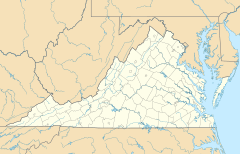Manakin Sabot, Virginia facts for kids
Quick facts for kids
Manakin Sabot
|
|
|---|---|
| Country | United States |
| State | Virginia |
| County | Goochland |
| Population
(2010)
|
|
| • Total | 4,634 |
| Time zone | UTC−5 (Eastern (EST)) |
| • Summer (DST) | UTC−4 (EDT) |
Manakin Sabot is a small, quiet community in Goochland County, Virginia, in the United States. It's not a city or a town with its own government, but rather an "unincorporated community." This means it's a group of villages, Manakin and Sabot, that are part of the larger county. It's located in a hilly area called the Piedmont, northwest of a bigger city called Richmond. It is part of the larger Richmond area.
History
Before Europeans arrived, the land around Manakin Sabot was home to the Monacan Native Americans. They spoke a language called Siouan, like other tribes in the uplands.
Early European Settlers
In the early 1700s, some of the first Europeans to settle here were French Protestants called Huguenots. They were religious refugees who had to leave France because of their beliefs. They came to Virginia from London in 1700 and 1701. The British Crown (the King of England) promised them land.
The Huguenots expected to settle near existing towns like Jamestown. Instead, officials gave them land about 20 miles up the James River. This land was already home to the Monacan people. One French settlement in Powhatan County became known as Manakin Town. The two villages in Goochland were named Manakin and Sabot.
The land for the Manakin colony was given by English King William III in 1699. He gave 10,000 acres to Marquis Olivier de la Muce. He was a Huguenot nobleman who had escaped from prison in France. The land was meant for a Huguenot settlement along the James River.
More than 500 Huguenots left England for Virginia in 1699. They traveled on ships like the "Pierre and Anthony" and "Mary and Ann." Four Huguenot ministers and two surgeons also came with them.
Life in the New Colony
Virginia welcomed these refugees. Many were educated and wealthy, bringing resources with them. The Colony even let the French Huguenots avoid paying taxes for seven years. When they arrived, they built homes and farms in the wilderness. They also built a church, a school, a hospital, and a blacksmith shop.
The first group of Huguenots faced many difficulties. Many were from cities and were not ready for life on the frontier. They asked the government for more help when another ship of refugees arrived. Slowly, the settlers learned to adapt. They moved from the village to their own farms nearby. By 1750, the original village was no longer active. Over time, the French settlers and their children married English settlers. Many of their descendants later moved west or south to other areas.
Growing the Area
Over the years, colonists developed the area into large farms called plantations. In the 1700s, farmers started growing wheat and other crops instead of just tobacco. This was because the market for crops changed.
Several important historic places are in Manakin Sabot. These include Ben Dover Farm, Dover Slave Quarter Complex, Huguenot Memorial Chapel and Monument, Oak Grove, Powell's Tavern, Rochambeau Farm, and Tuckahoe Plantation. Most of these were built between the colonial period and the mid-1800s. They are listed on the National Register of Historic Places because of their historical importance. Some of these farms continued to operate for agriculture into the 1900s.
Notable Residents
- Justin Verlander, a famous Major League Baseball player, grew up in Manakin Sabot.



